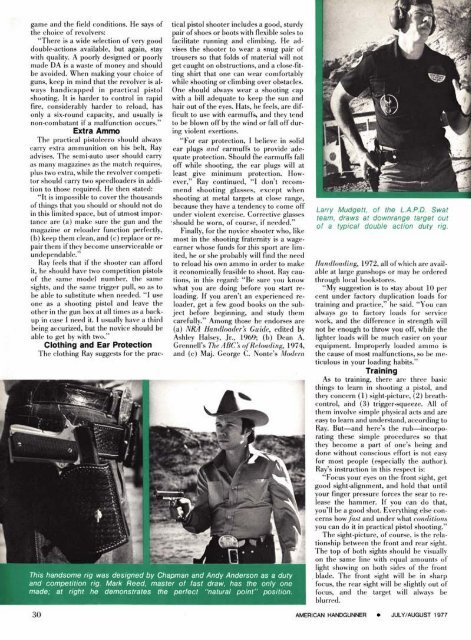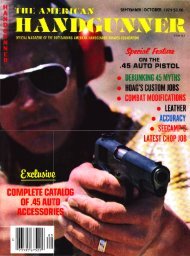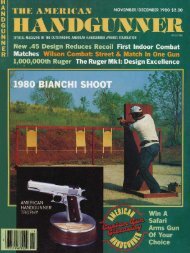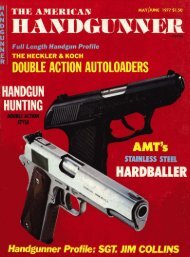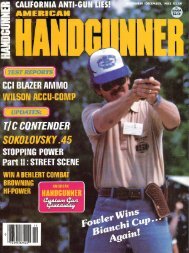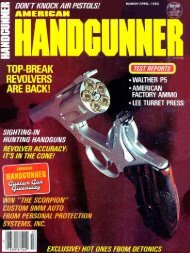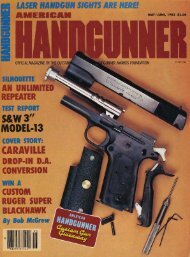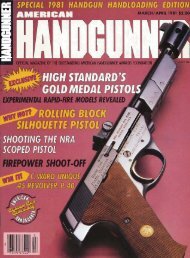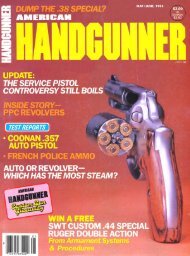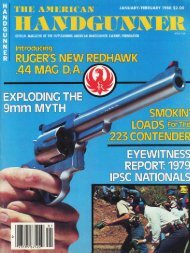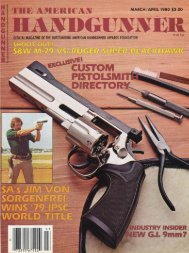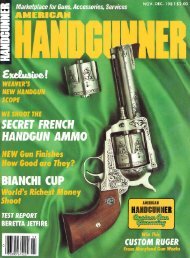American Handgunner July/August 1977
American Handgunner July/August 1977
American Handgunner July/August 1977
Create successful ePaper yourself
Turn your PDF publications into a flip-book with our unique Google optimized e-Paper software.
game and the field conditions. He says ofthe choice of revolvers:"There is a wide selection of very gooddouble-actions available, but again, staywith quality. A poorly designed or poorlymade DA is a waste of money and shouldbe avoided. When making your choice ofguns, keep in mind that the revolver is alwayshandicapped in practical pistolshooting. It is harder to control in rapidfire, considerably harder to reload, hasonly a six-round capacity, and usually isnon-combatant if a malfunction occurs."Extra AmmoThe ~ractical pistoleero should alwayscarry extra ammunition on his belt, Rayadvises. The semi-auto user should carryas many magazines as the match requires,plus two extra, while the revolver competitorshould carry two speedloaders in additionto those required. He then stated:'It is impossible to cover the thousandsof things that you should or should not doin this limited space, but of utmost importanceare (a) make sure the gun and themagazine or reloader function perfectly,(b) keep them clean, and (c) replace or repairthem if they become unserviceable orundependable."Ray feels that if the shooter can affordit, he should have two competition pistolsof the same model number, the samesights, and the same trigger pull, so as tobe able to substitute when needed. "I useone as a shooting pistol and leave theother in the gun box at all times as a backupin case I need it. I usually have a thirdbeing accurized, but the novice should beable to get by with two."Clothing and Ear ProtectionThe clothing Ray suggests for the prac-tical pistol shooter includes a good, sturdypair of shoes or boots with flexible soles tofacilitate running and climbing. He advisesthe shooter to wear a snug pair oftrousers so that folds of material will notget caught on obstructions, and a close-fittingshirt that one can wear comfortablywhile shooting or climbing over obstacles.One should always wear a shooting capwith a bill adequate to keep the sun andhair out of the eyes. Hats, he feels, are difficultto use with earmuffs, and they tendto be blown off by the wind or fall off duringviolent exertions."For ear protection, I believe in solidear plugs and earmuffs to provide adequateprotection. Should the earmuffs falloff while shooting, the ear plugs will atleast give minimum protection. However,"Ray continued, "I don't recommendshooting glasses, except whenshooting at metal targets at close range,because they have a tendency to come offunder violent exercise. Corrective glassesshould be worn, of course, if needed."Finally, for the novice shooter who, likemost in the shooting fraternity is a wageearnerwhose funds for this sport are limited,he or she probably will find the needto reload his own ammo in order to makeit economically feasible to shoot. Ray cautions,in this regard: "Be sure you knowwhat you are doing before you start reloading.If you aren't an experienced reloader,get a few good books on the subjectbefore beginning, and study themcarefully." Among those he endorses are(a) NRA Hanilloaderk Guide, edited byAshley Halsey, Jr., 1969; (b) Dean A.Grennell's The ABC's ($Reloading, 1974,and (c) Maj. George C. Nonte's ModernThis handsome rig was designed by Chapman and Andy Anderson as a dutyand competition rig. Mark Reed, master of fast draw, has the only onemade; at right he demonstrates the perfect "natural point" position.Larry Mudgett, of the L.A.P.D. Swatteam, draws at downrange target outof a typical double action duty rig.Handloading, 1972, all of which are availableat large gunshops or may be orderedthrough local bookstores."My suggestion is to stay about 10 percent under factory duplication loads fortraining " and oractice." he said. "You canalways go to factory loads for servicework, and the difference in strength willnot be enough to throw you off, while thelighter loads will be much easier on yourequipment. Improperly loaded ammo isthe cause of most malfunctions, so be meticulousin your loading habits."TrainingAs to training, there are three basicthings to learn in shooting a pistol, andthey concern (1) sight-picture, (2) breathcontrol,and (3) trigger-squeeze. All ofthem involve simple physical acts and areeasy to learn and understand, according toRay. But-andhere's the rub-incorpo-rating these simple procedures so thatthey become a part of one's being anddone without conscious effort is not easyfor most people (especially the author).Ray's instruction in this respect is:. "Focus your eyes on the front sight, getgood sight-alignment, and hold that untilyour finger pressure forces the sear to releasethe hammer. If you can do that,you'll be a good shot. Everything else concernshow just and under what conditionsyou can do it in practical pistol shooting."The sight-picture, of course, is the relationshipbetween the front and rear sight.The top of both sights should be visuallyon the same line with equal amounts ofIlight showing on both sides of the frontblade. The front sight will be in sharpfocus, the rear sight will be slightly out offocus, and the target will always beblurred.30 AMERICAN HANDGUNNER JULY/AUGUST <strong>1977</strong>


